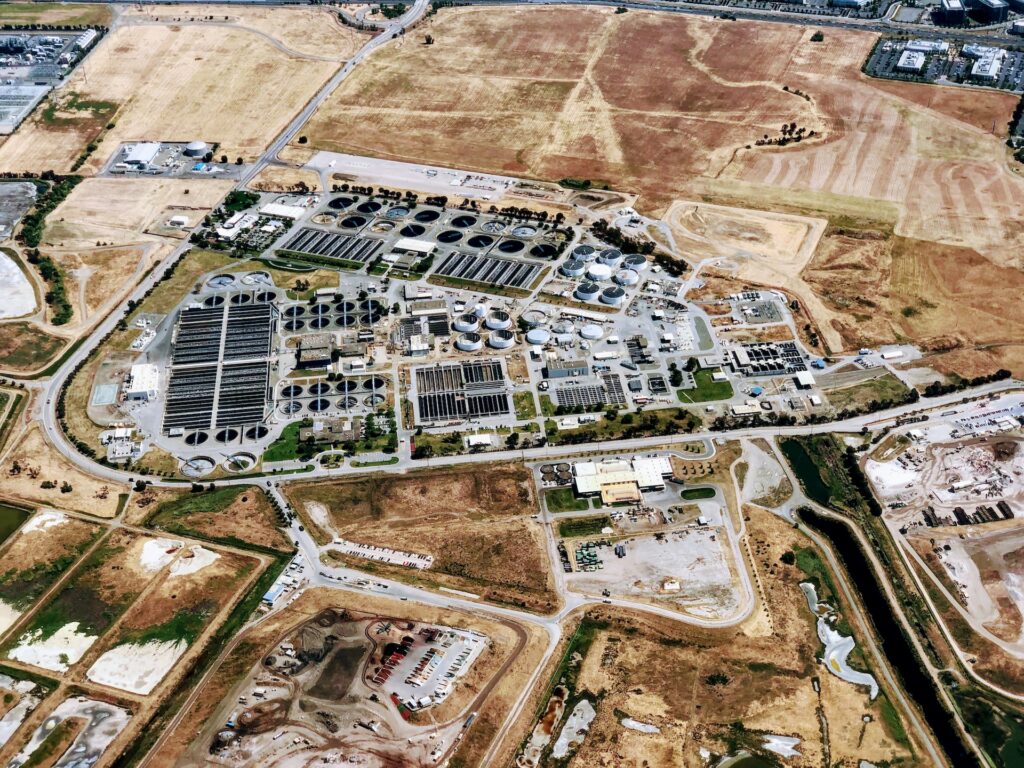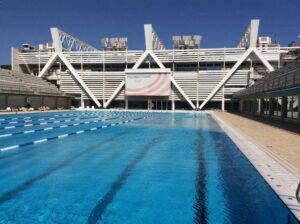04/10/2023 | Environmental | 8 MINUTE READ
Understanding Acid Mine Drainage: Causes, Effects, and Treatment

Mining operations are capable of producing considerable waste and pollution. Among the most significant contributors to this pollution is acid mine drainage, which occurs because of contact with mining activity. While all types of mines can produce this waste, it’s most commonly found with coal mines. The primary water quality issues that can be present in abandoned mines include acid mine drainage, alkaline mine drainage, and metal mine drainage.
Metal mine drainage occurs when high levels of lead or similar metals drain out from the abandoned mines. Alkaline mine drainage involves dolomite or calcite being present in high concentrations. Acid mine drainage is the most common water quality issue. It forms when highly acidic water contains ample amounts of heavy metals.
If the water within the mine has sulfur-bearing metals, a chemical reaction will occur that creates sulfuric acid. This fluid can be highly toxic and may lead to harmful effects in animals, plants, and humans. The following guide offers a comprehensive overview of the causes, effects, and treatment of acid mine drainage.

Acid Mine Drainage Nomenclature
Acid mine drainage involves the outflow of highly acidic water from coal mines or metal mines. It occurs naturally in certain environments because of the rock weathering process. However, it can be worsened as a result of large-scale disturbances in the earth, which is why this issue is common in mining. Other areas where earth is regularly disturbed include subdivisions, transportation corridors, and construction sites. Acid mine drainage may be present in all of these locations.
It’s also possible for acid mine drainage to be created with the liquid that drains from coal washeries, coal waste tips, coal handling facilities, and coal stocks. This water is extremely acidic and is considered acid mine drainage even though it didn’t originate in a mine. The toxic metals that are prevalent in these waters include iron and copper. When you combine these metals with a low pH, the water can be damaging to aquatic environments.
The acidic discharges that are produced from abandoned or active mines have long been referred to as acid mine drainage. Since the 1980s, this type of contaminated water has been known as:
- Acid rock drainage
- Neutral mine drainage
- Mining-influenced water
Acid rock drainage was introduced during the 1980s to refer to acidic drainage that came from sources other than active or abandoned mines. If the water isn’t acidic but still contains high concentrations of dissolved metals, it can be referred to as mining-influenced water or neutral mine drainage. However, acid mine drainage is the widely accepted term for the substance.
Occurrence of Acid Mine Drainage
It’s common for sub-surface mining to occur below the water table, which means that the water needs to be routinely pumped out of the mine to prevent flooding from occurring. Once a mine has been abandoned, the pumping will stop, which causes water to flood the mine. The majority of naturally occurring acid mine drainage issues begin with this step. Additional sources of acid mine drainage include coal spoils, mine waste rock dumps, and tailings piles.
Once metal sulfides are exposed to water and air, the oxidation process occurs in the surrounding rock, which produces acidity. The presence of bacteria colonies can further expedite metal ion decomposition. Since the ore in metal mines is usually a sulfide mineral, these mines can produce highly acidic discharges. While iron is the primary metal ion found in these mines, additional metals include copper, nickel, and zinc.
The amount of time it takes to detect acid mine drainage depends on the mine. It’s possible for this type of drainage to be detected in around two to five years after the mine started. However, there are times when the issue isn’t detected for a few decades.
Even after detection, acidic drainage can occur for many decades, which is why it’s considered a long-term environmental issue. As mentioned previously, this type of drainage can also be created by human activities at coal washeries and coal handling facilities.

Effects on pH
Acid mine drainage will usually cause pH levels in nearby waters to drop considerably. In fact, the pH can reach a level of -3.6, which is highly acidic and dangerous to the environment. The organisms that directly cause acid mine drainage are able to thrive in water with a pH that’s near zero.
It’s possible for a negative pH to occur if water evaporates from acidic pools, which will increase hydrogen ion concentration. Nearly 50% of coal mine discharges come with a pH that’s below 5.0. Acidic water is highly corrosive and can damage appliances and copper plumbing. This type of water is also harmful to plant and animal life if it gets into the environment. Drinking acidic water causes numerous health problems, which include everything from nausea to organ damage.
Identifying Acid Mine Drainage
In mining settings, the technique that’s most commonly used to ascertain the possibility for acid mine drainage is a geochemical assessment of various mine materials. This assessment maps the variability of specific geochemical parameters as well as acid generating characteristics. It includes:
- Sampling
- Static and kinetic geochemical testwork, which extends to everything from acid-base accounting to oxygen consumption tests
- Modelling oxidation and pollutant generation
- Modelling material composition
Treatment Methods
The many different treatments that can be used to remove the metals from acid mine drainage can be separated into passive treatment methods and active treatment methods. A passive treatment system treats effluents without the need for power, which makes them more affordable when compared to active treatment systems. In most cases, they also require much less maintenance.
The exact passive treatment you use depends on the water chemistry. Passive treatment systems are relatively modern and are designed to use limestone or sulfate-reducing bacteria to precipitate metals and neutralize acidity. They can be referred to as bioreactors or wetlands.
An example of an active system is a water treatment facility. The main difference between a passive treatment and an active one is that active systems can use caustic soda, hydrated lime, ammonia, and other hazardous chemicals. Passive treatment systems are better for the environment and allow for natural biological and chemical reactions to occur in the acid mine drainage.
A common active treatment is lime neutralization, which involves lime precipitation that occurs in a high-density sludge process. A slurry of the lime substance is placed into a large tank that holds the acid mine drainage. The purpose of this technique is to increase the water’s pH to around 9.0. At this pH level, the majority of toxic metals will become insoluble and effectively precipitate. Another active treatment at your disposal is calcium silicate neutralization, which removes free hydrogen ions to increase pH levels.
An example of a passive treatment involves constructed wetland systems. This solution was first developed in the 1980s for acid mine drainage. The wetlands will receive water that’s close to neutral after the water has been neutralized with a limestone treatment process.
Because the water is at near-neutral pH, metal precipitation will occur. This precipitation can result in sulfides being created. Anaerobic bacteria in the water is capable of changing sulfate ions directly into sulfide ions. These ions will then bind together with the metal ions, which precipitate out of the solution. The main benefit of using the constructed wetlands treatment method is that it’s highly affordable.

Why Acid Mine Drainage Can Reach pH Levels as Low as -3.6
As mentioned previously, the pH levels of acid mine drainage can drop as low as -3.6. When water evaporates from acidic pools, the amount of hydrogen ions in the water will increase, which turns the pH negative.
Once acid mine drainage reaches a pH level of 3.0 or above, soluble iron ions can precipitate as iron hydroxide, which is a yellow-orange solid. These precipitates cause water to become discolored and can smother animal and plant life found along the stream-bed. When this process occurs, more hydrogen ions are produced, which result in the pH levels dropping.
It’s common for acid mine discharges to consist of high levels of toxic metals and low levels of semi-metal ions, which include everything from manganese to lead. Heavy metals are only able to be dissolved in low-pH waters. Because high concentrations of metal sulfides are present in acid mine drainage, the pH levels will invariably be low. Acidic water can also be produced by such sources as plant decomposition, acid rain, and rock formations.
Conclusion
If acid mine drainage gets into local water supplies, it can result in a wide range of serious health complications that include everything from nervous system damage to high blood pressure. When a person consumes water that contains elevated levels of toxic heavy metals, their health can worsen significantly in a short period of time, which is why it’s important to prevent acid mine drainage from occurring in the first place.
Before a mine is selected, a geochemical assessment can be performed to determine if acid mine drainage is likely and what its effects would be. At the moment, scientists are exploring acid mine drainage to identify if any unique soil bacteria can accommodate new pharmaceutical discoveries. Since soil microbes have been used in the creation of effective drugs for decades, it’s believed that extreme environments are bountiful sources for future research.
Posted by Dominic O'Donnell on April 10, 2023
Sensorex is a global leader in the design and manufacture of quality sensors for water quality and process applications. The company offers more than 2000 sensor packages for pH, ORP, conductivity, dissolved oxygen, free chlorine, chlorine dioxide, UV transmittance and other specialty measurements, as well as a full line of sensor accessories and transmitters. Its expert technical support engineers solve analytical sensor challenges with custom designs and off the shelf products.




